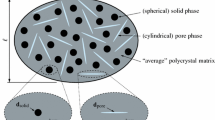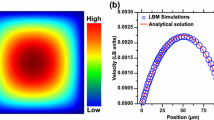Abstract
As concrete is exposed to the elements, its underlying microstructure can be attacked by a variety of aggressive agents. For example, rainwater and groundwater can degrade the concrete by dissolving soluble constituents such as calcium hydroxide. Using computer simulation, this paper examines the effects of calcium hydroxide dissolution on two material properties: the percolation properties or connectivity of the capillary pore space, and the relative ionic diffusivity. A microstructural model for cement paste is used to produce a hydrated specimen which is subsequently subjected to the leaching process. Pore space percolation characteristics and relative ionic diffusivity are computed throughout the leaching process as a function of total capillary porosity. Material variables examined are water: solids ratio and silica fume content. Percolation theory is used to develop the concept of a critical volume fraction of calcium hydroxide plus capillary pore space. It is shown that this critical combined volume fraction determines the magnitude of the effect of leaching on relative ionic diffusivity.
Resume
Quand le béton est exposé aux éléments, sa microstructure sous-jacente peut être agressée par divers agents. Ainsi, la pluie et l'eau souterraine peuvent détériorer le béton en dissolvant les composants solubles tels que l'hydroxyde de calcium. A l'aide d'une simulation par ordinateur, on examine ici les effects de la dissolution d'hydroxyde de calcium sur deux propriétés du matériau: la percolation de l'espace interstitiel et la diffusivité ionique relative. On utilise un modèle microstructural de la pâte de ciment pour produire une éprouvette hydratée qu'on soumet ensuite au lessivage. On calcule les caractéristiques de la percolation interstitielle et la diffusivité ionique relative tout au long du phénomène de lessivage en fonction de la porosité capillaire totale. Les variables du matériau considérées sont le rapport eau/solides et la teneur en micro-silice. On se sert de la théorie de la percolation pour développer le concept de fraction volumique critique d'hydroxyde de calcium en combinaison avec l'espace interstitiel capillaire. On montre que cette combinaison critique détermine l'importance de l'effet de lessivage sur la diffusivité ionique relative.
Similar content being viewed by others
References
Clifton, J. R. and Knab, L. I., ‘Service life of concrete’, NISTIR 89-4086 (US Department of Commerce, 1989).
Pommersheim, J. M. and Clifton, J. R., ‘Models of transport processes in concrete’, NISTIR 90-4405 (US Department of Commerce, 1990).
Atkinson, A. and Nickerson, A. J., ‘The diffusion of ions through water-saturated cement’,J. Mater. Sci. 19 (1984) 3068–3078.
Garboczi, E. J., ‘Permeability, diffusivity, and microstructural parameters: a critical review’,Cement Concr. Res. 20 (1990) 591–601.
Bentz, D. P. and Garboczi, E. J., ‘A digitized simulation model for microstructural development’, in “Advances in Cementitious Materials”, Ceramic Transactions Vol. 16 (1991) pp. 211–226.
Garboczi, E. J. and Bentz, D. P., ‘Computer simulation of the diffusivity of cement-based materials’,J. Mater. Sci. 27 (1992) 2083–2092.
Press, W. H., Flannery, B. P., Teukolsky, S. A. and Vetterling, W. T., ‘Numerical Recipes: The Art of Scientific Computing’ (Cambridge University Press, Cambridge, 1986).
Garboczi, E. J. and Bentz, D. P., ‘Digital simulation of the aggregate-cement paste interfacial zone in concrete’,J. Mater. Res. 6(1) (1991) 196–201.
Young, J. F. and Hansen, W., ‘Volume relationships for CSH formation based on hydration stoichiometry’,Mater. Res. Soc. Symp. Proc. 85 (1987) 313–322.
Bentz, D. P. and Garboczi, E. J., ‘Percolation of phases in a three-dimensional cement paste microstructural models’,Cement Concr. Res. 21(2) (1991) 325–344.
Idem, ‘Simulation studies of the effects of mineral admixtures on the cement paste-aggregate interfacial zone’,ACI Mater. J. 88(5) (1991) 518–529.
Zallen, R., ‘The Physics of Amorphous Solids’ (Wiley, New York, 1983).
Stauffer, D., ‘Introduction to Percolation Theory’ (Taylor and Francis, London, 1985).
Zimblemann, R., ‘A contribution to the problem of cement-aggregate bond’,Cement Concr. Res. 15 (1985) 801–808.
Mindess, S. and Young, J. F., ‘Concrete’ (Prentice-Hall, Englewood Cliffs, New Jersey, 1981).
Scuderi, C. A., Mason, T. O. and Jennings, H. M., ‘Impedance spectroscopy of hydrating cement pastes’,J. Mater. Sci. 26 (1991) 349–353.
Author information
Authors and Affiliations
Rights and permissions
About this article
Cite this article
Bentz, D.P., Garboczi, E.J. Modelling the leaching of calcium hydroxide from cement paste: effects on pore space percolation and diffusivity. Materials and Structures 25, 523–533 (1992). https://doi.org/10.1007/BF02472448
Issue Date:
DOI: https://doi.org/10.1007/BF02472448




